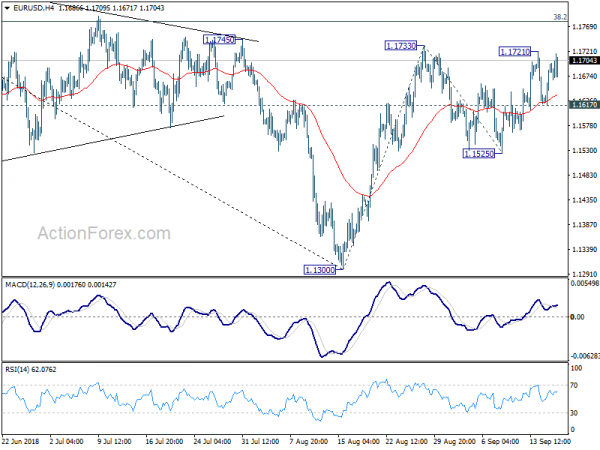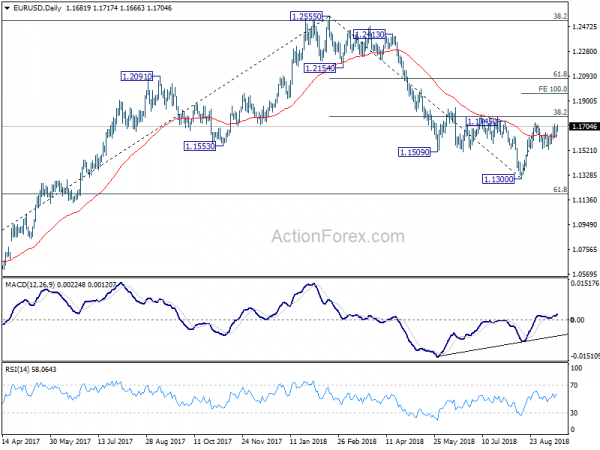This time, the escalation of US-China trade war is largely ignored by the financial markets. There were just some very brief knee jerk reaction in stock and the currency markets. Yen and Dollar are both back under pressure after initial rebound. On the other hand, Australian Dollar looks immune from trade risks and trades broadly higher today, leading other commodity currencies. Though, one development to note is that Euro could be quietly picking up some momentum, helped by softness in Sterling. We might see Euro and Aussie compete for the strongest spot for the rest of the day.
At the time of writing, European indices are trading all up slightly. FTSE is up 0.04%, DAX up 0.15% and CAC up 0.23%. German 10 year bund yield reversed initial loss and is up 0.008 at 0.466. Earlier in Asia, Nikkei closed up 1.41%, Hong Kong HSI up 0.56% and Singapore Strait Times was just down -0.07%. Most notably, China Shanghai SSE reversed earlier loss and closed up 1.82% at 2699.95, just shy of 2700 handle. The strong close is indeed suggesting short term bottoming, just ahead of 2638.30 key support (2016 low). But question remains on how strong the rebound could be.
Technically, EUR/JPY has already caught up with USD/JPY and GBP/JPY and broke 131.00 minor resistance to resume recent rebound. It’s time for EUR/USD to show whether it can break 1.1733 resistance. Dollar is staying in range against Australian Dollar and Canadian Dollar. But fresh selling is seen in early US session. USD/CAD could challenge 1.2975 temporary low while AUD/USD could take on 0.7228 temporary top during the session.
China MOFCOM, Foreign Ministry and CSRS responded to new tariffs
China Ministry of Commerce issued a brief statement in response to new round of US tariffs. It said “to protect its legitimate rights and interests and order in international free trade, China is left with no choice but to retaliate simultaneously”. Also, “the United States insists on increasing tariffs, bringing new uncertainties to bilateral trade negotiations. China hopes the United States would recognize the negative consequences of its actions, and take convincing steps to correct its behavior in a timely manner.”
Foreign Ministry spokesman Geng Shuang said in a regular press briefing that “China has always emphasized that the only correct way to resolve the China-U.S. trade issue is via talks and consultations held on an equal, sincere and mutually respectful basis. But he criticized that “at this time, everything the United States does does not give the impression of sincerity or goodwill.”
No details are provided today. But based on information released last month, China already has a list of USD 60B of US goods to tariff any time.
Fang Xinghai, vice chairman of the China Securities Regulatory Commission (CSRC) criticized that the Trump’s new round of tariffs on China has “poisoned” the atmosphere for negotiations. Fang also warned that “President Trump is a hard-hitting businessman, and he tries to put pressure on China so he can get concessions from our negotiations. I think that kind of tactic is not going to work with China.” Also, according to Fang, “if he puts tariffs on all Chinese exports to the United States – which he says he will – even in that scenario, the negative impact on China’s economy is about 0.7 percent.”
USTR announced 10% tariffs on Chinese imports, to increase to 25% on Jan 1 2019
US Trade Representative finally announced the tariffs on USD 200B of Chinese imports, effective September 24, 2018. The initial tariff rate is 10%. Staring January 1, 2019, the tariff rate will be increased to 25%. The list of products covers 5745 lines of the original 6031 lines proposed back in July 10. 297 lines were fully or partially removed from the list. Products include consumer electronics, certain chemical inputs for manufactured goods, textiles and agriculture; certain health and safety products such as bicycle helmets, and child safety furniture such as car seats and playpens.
The tariffs were part of the follow-up actions on Section 301 investigations. China’s unfair trade practices were repeated in the statement. These include, forced technology transfer, depriving UA companies to set market based terms in negotiations, unfairly facilitating systematic investment in acquisition of US technology companies, and cyber intrusions to US commercial computer networks for valuable business information.
Trump warned in a statement that new round of tariffs on around USD 267B of additional imports will be pursued if China retaliates. He added that “we have been very clear about the type of changes that need to be made, and we have given China every opportunity to treat us more fairly.” “But, so far, China has been unwilling to change its practices.”
Responses on tariffs: Trump did not heed American warnings
Here are some responses from the industry on Trump’s tariffs on China:
The U.S. Chamber of Commerce president and CEO Thomas Donohue said in a statement, “today’s decision makes clear that the administration did not heed the numerous warnings from American consumers and businesses about rising costs and lost jobs on Main Street, in factories, and on farms and ranches across the country. ”
Dean Garfield, president of the Information Technology Industry Council said in a statement, “President Trump’s decision to impose an additional $200 billion is reckless and will create lasting harm to communities across the country.”
Hun Quach, the Retail Industry Leaders Association’s s vice president for international trade said in a statement, “we are extremely discouraged by the Administration’s announcement to levy tariffs on millions of products American consumers buy every day.” “We are disappointed to see that warnings from importers and exporters representing every sector of the U.S. economy have not been heeded with no time for mitigation.”
Jay Timmons, National Association of Manufacturers (NAM) President and CEO, said in a statement “more U.S. tariffs and Chinese retaliation risk undoing that progress and moving our economy in the wrong direction.” “Now is the time for talks—not just tariffs”.
EU companies in China releases report with 828 reform recommendations in 14 areas
The European Union Chamber of Commerce in China released an annual position paper today, urging China to accelerate reforms. The paper described the widening gap of the maturing economy and the shortcomings of reforms and opening agenda as “reform deficit”. Such reform deficit is seen as the “root cause” of tensions in the global economic tensions which resulted in the US-China trade war. And, “the strong reaction from the United States with its escalation of tariffs is, albeit undesirable, a direct response to these deficiencies, many of them longstanding.”
The paper examines 14 common concerns faced by European companies. These issues “continue to hold back China’s development and prevent businesses from serving their core function”. And the paper urged that “each of these issues should be viewed by Chinese officials as a challenge to overcome in the years ahead.”
The areas of concerns include access to licenses, complex and lengthy administrative procedures, consultation and communication, cybersecurity, IPR and R&D, overlapping regulations and interdepartmental coordination, market access barriers, SOE-related issues, standards setting, transparency issues, unclear regulations and unpredictable enforcement, unequal and unfair treatment, unfair procurement systems and SMEs. The 33-page paper listed out a accumulative total of 828 recommendations.
The press statement and full rebound can be report here.
EU Tusk laid down three key Brexit issues to focus on at Salzburg meeting
Brexit will be an important topic in the upcoming European Council meeting in Salzburg on September 19 and 20. European Council President Donald Tusk laid out three key issues to focus on, in a statement:
- First, we should reach a common view on the nature and overall shape of the joint political declaration about our future partnership with the UK.
- Second, we will discuss how to organise the final phase of the Brexit talks, including the possibility of calling another European Council in November.
- Third, we should reconfirm the need for a legally operational backstop on Ireland, so as to be sure that there will be no hard border in the future.
Tusk said a no deal scenario is “still quite possible”. But, “if we all act responsibly, we can avoid a catastrophe.”
Separately, UK Brexit Minister Dominic Raab told Spiegel newspaper that Prime Minister Theresa May’s Chequers plan are “so far the only proposals that guarantee smooth trade between Britain and the EU and take account of the specific problems in Ireland.” And he saw “no other credible alternative, either from here or from the EU side.”
Raab also added that “We have already made extensive compromises.. We have shown ourselves to be very pragmatic and ambitious. Now the ball is in the European Union’s court.”
RBA minutes reiterated no strong case for near term rate move
The minutes of September 4 RBA meeting provided practically no surprise at all. most importantly, RBA reiterated that “the next move in the cash rate would more likely be an increase than a decrease.” However, “there was no strong case for a near-term adjustment in monetary policy.”
RBA also noted that a few global central banks including the Fed were expected to continuing rate hikes. This had been reflected in the markets, “most notably a broad-based appreciation of the US dollar” that “raised risks” for some, especially for “fragile emerging” markets. However, “the modest depreciation of the Australian dollar was helpful for domestic economic growth.”
The central bank also noted that there were “still significant tensions around global trade policy” that represented a “material risk” to the global outlook.
Also from Australia, house price index dropped -0.7% qoq in Q2, matched expectations.
EUR/USD Mid-Day Outlook
Daily Pivots: (S1) 1.1635; (P) 1.1668; (R1) 1.1717; More…..
EUR/USD strengthens further today and focus is back on 1.1733 resistance Break will resume whole rebound from 1.1300. At this point, we’d still expect strong resistance from 38.2% retracement of 1.2555 to 1.1300 at 1.1779 to limit upside, at least on first attempt. Break of 1.1617 minor support will turn bias back to the downside. Further break of 1.1525 support will indicate completion of this corrective rebound from 1.1300. However, firm break of 1.1779 will extend the rise to 100% projection of 1.1300 to 1.1733 from 1.1525 at 1.1958.
In the bigger picture, a medium term bottom should be in place at 1.1300, on bullish convergence condition in daily MACD and some consolidations would be seen. But still, note that EUR/USD was rejected by 38.2% retracement of 1.6039 (2008 high) to 1.0339 (2017 low) at 1.2516. That carries some long term bearish implications. Thus, we’d expect fall from 1.2555 high to resume after consolidation completes. Below 1.1300 should send EUR/USD through 61.8% retracement of 1.0339 to 1.2555 at 1.1186. And, in that case, EUR/USD would head to retest 1.0339 (2017 low).
Economic Indicators Update
| GMT | Ccy | Events | Actual | Forecast | Previous | Revised |
|---|---|---|---|---|---|---|
| 01:30 | AUD | House Price Index Q/Q Q2 | -0.70% | -0.70% | -0.70% | |
| 01:30 | AUD | House Price Index Y/Y Q2 | -0.60% | 2.00% | ||
| 01:30 | AUD | RBA Minutes Sep | ||||
| 12:30 | CAD | Manufacturing Sales M/M Jul | 0.90% | 1.00% | 1.10% | 1.30% |
| 14:00 | USD | NAHB Housing Market Index Sep | 66 | 67 | ||
| 20:00 | USD | Net Long-term TIC Flows (USD) Jul | 65.1B | -36.5B |















